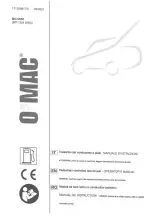
EN - 29
SAFETY INSTRUCTION
Always replace damaged, bent or worn pairs
of cutting means, together with their nuts and
bolts, in order to maintain their balance.
WARNING
All work on the cutting means (disassembly,
sharpening, balancing, repairing, reassembly
and/or replacing) are demanding jobs that
require special skills as well as special tools;
For safety reasons, these jobs are best
carried out at a Authorised Service Centre.
ATTENTION
Always use original cutting means bearing
the code indicated in the “Technical Data”.
NOTE
Given product evolution, the cutting means
listed in the "Technical Data" table may be
replaced in time with others having similar
interchangeable and operating safety features.
9.3 REPLACING FRONT / REAR WHEELS
9.3.1 Preliminary operations
DANGER
Use a suitable lifting device.
Before changing the wheels it is necessary
to complete some preliminary operations:
1.
Position the machine on a solid
and even surface that guarantees
stability of the machine.
2.
Stop the machine;
3.
Remove the key from the ignition;
4.
Position the lifting device in the
lifting position near the wheel to be
changed (par. 9.3.2; par. 9.3.3).
5.
Check that the lifting device is perfectly
perpendicular to the ground.
9.3.2 Choice and positioning of the
jack on the rear wheels
Position some wooden wedges (fig. 32.A)
at the base of the wheel (fig. 32.B) next to
the wheel to be changed (fig. 32.C).
For models with rear collection:
•
The maximum possible jack height
when closed is 110 mm. (fig. 33).
•
Position the jack under the rear plate (fig.
34.A) at 180 mm from the side edge (fig. 33).
For side discharge models:
•
The maximum possible jack height
when closed is 110 mm. (fig. 35).
•
Position the jack under the rear axle, in the
point indicated in the diagram (fig. 36.A).
NOTE
In this position the jack allows you to
raise only the wheel to be changed.
9.3.3 Choice and positioning of the
jack on the front wheels
1.
Position some wooden wedges (fig. 37.A)
at the base of the wheel (fig. 37.B) behind
the wheel to be changed (fig. 37.C).
2.
The maximum possible jack height
when closed is 110 mm.
3.
Place on top of the jack (fig. 38.A) a
squared piece of wood (fig. 38.B) having
a cross-section of about 10 x 10 cm.
ATTENTION
The thickness of the wood prevents
damage to the front axle.
4.
During this stage, keep the wooden
pad balanced on the jack with one
hand. Lift the jack making sure that the
wooden pad rests against the frame
and the structural parts (fig. 38.C).
Summary of Contents for EXPERIENCE Estate 798e
Page 5: ...F A E G H C B A D E F G A H C B A D B C C A 4 3 I II ...
Page 6: ...A C C B OK NO A B C D D E F F G G B 2 A C B 2 A D C B D 1 E D E 1 A B B 1 B B 5 I II 6 ...
Page 7: ...A B B A 8 7 9 ...
Page 8: ...A B C C D D H H E G F G F E 5 H H I I I I J K O N L O N M 10 15 cm A A C B III 10 11 ...
Page 10: ...1 3 A B A A A C B 14 15 16 17 18 19 20 ...
Page 11: ...I II A A B A 1 B A D C B A E TEST BEFO RE USE TEST RESET 22 23 21 25 24 ...
Page 12: ...A 28 A 26 A H H 30 mm H 10 mm H 20 mm H 0 mm 27 A C B D A C B A H 29 30 ...
Page 13: ...31 A A B C 180 mm 110 mm 32 33 ...
Page 14: ...38 B A C C 39 A D B C A A B C 110 mm 34 35 A A 36 37 ...
Page 15: ...42 A B C D D 41 43 40 A B I II ...
Page 16: ...A1 A2 B D C H J F I E m a x 2 4 5 N 2 5 k g m a x 9 8 0 N 1 0 0 k g C G K 44 ...
Page 1051: ......
Page 1052: ...ST S p A Via del Lavoro 6 31033 Castelfranco Veneto TV ITALY dB LWA Type s n Art N ...
















































